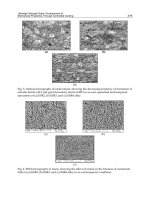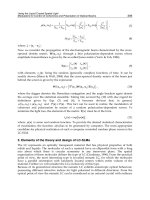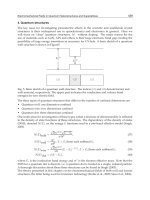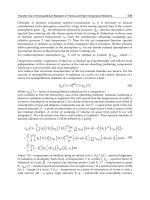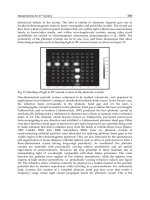Rubber Compounding - Chemistry and Applications Part 12 docx
Bạn đang xem bản rút gọn của tài liệu. Xem và tải ngay bản đầy đủ của tài liệu tại đây (1.03 MB, 64 trang )
11
Vulcanization
Frederick Ignatz-Hoover and Brendan H. To
Flexsys America LP, Akron, Ohio, U.S.A.
I. INTRODUCTION—TERMINOLOGY
***
The following is a short list of terminology commonly used within rubber
industry discussions of vulcanization of general-purpose elastomers. Where
indicated, reference is made to specific test methodologies.
Vulcanization is the process of treating an elastomer with a chemical to
decrease its plasticity, tackiness, and sensitivity to heat and cold and
to give it useful properties such as elasticity, strength, and stability.
Ultimately, this process chemically converts thermoplastic elasto-
mers into three-dimensional elastic networks. This process converts
a viscous entanglement of long-chain molecules into a three-
dimensional elastic network by chemically joining (cross-linking)
these molecules at various points along the chain. The process of
vulcanization is depicted graphically in Figure 1. In this diagram,
the polymer chains are represented by the lines and the cross-links
by the black circles.
Scorch refers to the initial formation of an extensive three-dimensional
network rendering the compound elastic. The compound is thus no
longer plastic or deformable and cannot be shaped or further pro-
cessed. Scorch safety is the length of time for which the compound
*
Although based on ASTM D-1566-80b, these definitions have been modified to fit this
discussion.
4871-9_Rodgers_Ch11_R2_052404
MD: RODGERS, JOB: 03286, PAGE: 505
Copyright © 2004 by Taylor & Francis
can be maintained at an elevated temperature and still remain plas-
tic. This time marks the point at which the plastic material begins
the chemical conversion to the elastic network. Thus if the com-
pound scorches before it is formed into the desirable shape or com-
posite structure it can no longer be used. Time to scorch is thus
important because it indicates the amount of time (heat history) the
compound may be exposed to heat during shaping and forming
operations before it becomes an intractable mass.
Rate of cure or cure rate describes the rate at which cross-links form.
After the point of scorch, the chemical cross-linking continues pro-
viding more cross-links and thus greater elasticity or stiffness (mod-
ulus). The rate of cure determines how long a compound must be
cured in order to reach ‘‘optimum’’ properties.
Cure time is the time required to reach a desired state of cure. Most
common lab studies use the t
90
cure time, which is the time required
to reach 90% of the maximum cure.
State of cure refers to the degree of cross-linking (or cross-link density)
of the compound. State of cure is commonly expressed as a percent-
age of the maximum attainable cure (or cross-link density) for a given
cure system. The elastic force of retraction, elasticity, is directly pro-
portional to the cross-link density or number of cross-links formed in
the network.
Reversion refers to the loss of cross-link density as a result of non-
oxidative thermal aging. Reversion occurs in isoprene-containing
polymers to the extent that the network contains polysulfidic cross-
links. Reversion converts a polysulfidic network into a network rich
in monosulfidic and disulfidic cross-links and, most important, one
that has a lower cross-link density than the original network. Re-
Figure 1 In vulcanization the randomly oriented chains of raw rubber become
cross-linked as indicated diagrammatically at the right.
4871-9_Rodgers_Ch11_R2_052404
MD: RODGERS, JOB: 03286, PAGE: 506
Copyright © 2004 by Taylor & Francis
version does not occur or hardly occurs in isoprene polymers cured
with vulcanization systems designed to produce networks rich in
monosulfidic and disulfidic cross-links. Reversion is commonly
characterized by the time required for a defined drop in torque in
the rheometer as measured from the maximum observed torque.
‘‘Network maturation’’ is a term used to describe chemical changes to
the network imparted by the action of the curatives through con-
tinued heating beyond the cure time required to provide for optimal
properties. In isoprene polymers the effect is commonly referred to
as reversion. However, in butadiene-containing polymers the effect
is to reduce polysulfidic networks to networks rich in monosulfidic
and disulfidic cross-links and having greater cross-link density than
the original network. This slow increase in modulus with time is
often called a ‘‘marching modulus.’’
Vulcanizing agents are chemicals that will react with active sites in the
polymer to form connections or cross-links between chains.
An accelerator is a chemical used in small amounts with a vulcanizing
agent to reduce the time of (accelerate) the vulcanization process. In
sulfur vulcanization today, accelerators are used to control the on-
set, speed, and extent of reaction between sulfur and elastomer.
Activators are materials added to an accelerated vulcanization system
to improve acceleration and to permit the system to realize its full
potential of cross-links.
Retarders are chemicals used to reduce the tendency of a rubber com-
pound to vulcanize prematurely by increasing scorch delay (time
from beginning of the heat cycle to the onset of vulcanization).
Ideally, a retarder would have no effect on the rate of vulcanization.
Such an ideal retarder has been called a prevulcanization inhibitor,
or PVI.
The kinetics of vulcanization are studied using curemeters or rheom-
eters that measure the development of torque as a function of time at a given
temperature. An idealized cure curve is given in Figure 2. Several important
values derived from the rheometer characterize the rate and extent of
vulcanization of a compound. Critical values include the following.
MI or Rmin. The minimum torque in the rheometer. This parameter
often correlates well with the Mooney viscosity of a compound
(Fig. 2).
M
h
or Rmax. The maximum torque achieved during the cure time.
t
s2
. The time required for the state of cure to increase to two torque
units above the minimum at the given cure temperature. This param-
eter often correlates well with the Mooney scorch time.
4871-9_Rodgers_Ch11_R2_052404
MD: RODGERS, JOB: 03286, PAGE: 507
Copyright © 2004 by Taylor & Francis
t
25
. The time required for the state of cure to reach 25% of the full
cure defined as (M
h
À Ml). Generally a state of cure of about 25–
35% is necessary to prevent the development of porosity when a
large rubber article is removed from a curing press. This level of
cure also provides enough strength to prevent the article from tearing
as it is removed from a curing mold.
t
90
. The time required to reach 90% of full cure defined as M
h
À Ml.
t
90
is generally the state of cure at which the most physical pro-
perties reach optimal results.
II. VULCANIZING AGENTS
Sulfur is the oldest and most widely used vulcanizing or cross-linking agent
and will be the vulcanizing agent of interest in most of this discussion. The
majority of cure systems in use today involve the generation of sulfur-
containing cross-links, usually with elemental sulfur in combination with an
organic accelerator. In recent years, the proportion of sulfur has tended to
fall and the levels of accelerator and the use of sulfur donors have increased
to give great improvements in the thermal and oxidative stability of the
vulcanizate. Other vulcanization systems that do not use sulfur or sulfur
donors are less commonly used and include various resins such as resorcinol-
formaldehyde resins, urethanes, or peroxides. Metal oxides or sulfur-acti-
vated metal oxides can be used for halogenated elastomers.
Figure 2 Rheometer curve.
4871-9_Rodgers_Ch11_R2_052404
MD: RODGERS, JOB: 03286, PAGE: 508
Copyright © 2004 by Taylor & Francis
About 150 years ago, Goodyear (1) in the United States and Hancock
(2) in England discovered that India rubber could be changed by heating it
with sulfur so that it was not greatly affected by heat, cold, and solvents. This
process was termed ‘‘vulcanization’’ deriving from the association of heat and
sulfur with the Vulcan of mythology.
Since that time, many other chemicals have been examined as possible
vulcanizing agents with some degree of success. Sulfur vulcanizates provide
an outstanding balance of cost and performance, exhibiting excellent strength
and durability for very low cost. No other cure system has, on its own,
successfully competed with sulfur as a general-purpose vulcanizing agent.
One limitation imposed upon the use of sulfur as a vulcanizing agent is that
the elastomer must contain some chemical unsaturation. In saturated elas-
tomers, other chemicals, particularly organic peroxides, have been found
quite useful.
We will therefore consider elemental sulfur and sulfur-bearing chem-
icals (sulfur donors) as one class of vulcanizing agents and non-sulfur vul-
canizing agents as a second class.
A. Sulfur and Sulfur Donors
Sulfur vulcanization occurs by the formation of sulfur linkages or cross-links
between rubber molecules, as shown in Figure 3. In conventional sulfur
vulcanization (generally formulated as a high sulfur-to-accelerator ratio) the
resultant network is rich in polysulfidic sulfur linkages. Sulfur chain linkages
can contain six or more sulfur atoms. Lower sulfur-to-accelerator ratios
produce networks that are characterized by a greater number of sulfur
linkages containing fewer sulfur atoms. Thus, the so-called efficient vulcan-
ization systems produce higher cross-link densities for the same loading of
sulfur. At very low sulfur-to-accelerator ratios, networks can be produced
that are composed predominantly of monosulfidic and disulfidic cross-links.
Figure 4 depicts the general changes in vulcanizate physical properties
as the vulcanization state of the rubber changes. As the cross-link density of
the vulcanizate increases (or the molecular weight between cross-links
decreases), elastic properties such as tensile and dynamic modulus, tear and
Figure 3 Sulfur vulcanization.
4871-9_Rodgers_Ch11_R2_052404
MD: RODGERS, JOB: 03286, PAGE: 509
Copyright © 2004 by Taylor & Francis
tensile strength, resilience, and hardness increase whereas viscous loss prop-
erties such as hysteresis decrease. Further increases in cross-link density will
produce vulcanizates that tend toward brittle behavior (see Fig. 4). Thus at
higher cross-link densities such properties as hardness and tear and tensile
strength plateau or begin to decrease. As a consequence, proper compounding
must be done to provide the best balance in properties for the specified
application.
Unaccelerated sulfur vulcanization is a slow, inefficient process. For this
reason, over a century of research efforts have been directed toward the de-
velopment of materials to improve the efficiency of this process. The activa-
tors, accelerators, and retarders to be discussed in later sections have resulted
from these endeavors.
Another class of chemicals, known as sulfur donors, have been devel-
oped to improve the efficiency of sulfur vulcanization. These materials are
used to replace part or all of the elemental sulfur normally used in order to
produce vulcanized products containing fewer sulfur atoms per cross-link. In
other words, these materials make more efficient use of the available sulfur.
The two most common sulfur donors are the disulfides tetramethylthiuram
(TMTD
*
)(1) and dithiodimorpholine (DTDM) (2).
*
A complete list of the abbreviations used in this chapter is given in Table 1.
Figure 4 Effects of vulcanization on physical properties. 1, Tear strength; 2, dynamic
modulus; 3, hardness; 4, hysteresis, permanent set; 5, static modulus; 6, tensile strength.
4871-9_Rodgers_Ch11_R2_052404
MD: RODGERS, JOB: 03286, PAGE: 510
Copyright © 2004 by Taylor & Francis
Table 1 Recognized Industry Abbreviations for Accelerators
Abbreviation Chemical name Flexsys trade name
CBS N-Cyclohexyl-2-benzothiazolesulfenamide Santocure CBS
CTP N-(Cyclohexylthio)phthalimide Santogard PVI
DBTU N,NV-Dibutylthiourea
DCBS N,N-Dicyclohexyl-2-benzothiazolesulfenamide Santocure DCBS
DETU N,NV-Diethythiourea
DOTG Di-o-tolylguanidine
DPG Diphenylguanidine Perkacit DPG
DPTH Dipentamethylenethiuram hexasulfide
DTDM Dithiodimorpholine Sulfasan DTDM
ETU Ethylenethiourea
MBS 2-(Morpholinothio)benzothiazolesulfenamide Santocure MBS
MBT 2-Mercaptobenzothiazole Perkacit MBT
MBTS Benzothiazyl disulfide Perkacit MBTS
NDPA N-Nitrosodiphenylamine
PEG Polyethylene glycol
TBBS N-t-Butyl-2-benzothiazolesulfenamide Santocure TBBS
TDEDC Tellurium diethyldithiocarbamate Perkacit TDEC
TETD Tetraethylthiuram disulfide Perkacit TETD
TMQ Polymerized 2,2,4-trimethyl-1,2-dihydroquinoline Flectol TMQ
TMTD Tetramethylthiuram disulfide Perkacit TMTD
TMTM Tetramethylthiuram monosulfide Perkacit TMTM
TMTU Trimethylthiourea
ZBDC Zinc dibutyldithiocarbamate Perkacit ZDBC
ZBPD Zinc o-di-n-butylphosphorodithioate Vocol ZBPD
ZDEC Zinc diethyldithiocarbamate Perkacit ZDEC
ZDMC Zinc dimethyldithiocarbamate Perkacit ZDMC
ZMBT Zinc salt of 2-mercaptobenzothiazole Perkacit ZMBT
6PPD N-1,3-Dimethylbutyl-N-phenyl-p-phenylenediamine Santoflex 6PPD
ETPT Bis(diethyl thiophosphoryl) trisulfide
BDITD Bis(diisopropylthiophosphoryl) disulfide
4871-9_Rodgers_Ch11_R2_052404
MD: RODGERS, JOB: 03286, PAGE: 511
Copyright © 2004 by Taylor & Francis
Tetramethylthiuram acts as an accelerator as well as a sulfur donor. As a
consequence, compounds containing TMTD tend to be cure rate activated;
that is, they are more scorchy and have faster cure rates. These materials are
usually used with the objective of improving thermal and oxidative aging
resistance. Use of sulfur donors increases the level of mono- and disulfidic
cross-links, which are reversion-resistant and more stable toward oxidative
degradation. However, sulfur donors can also be used to reduce the possibility
of sulfur bloom (by reducing the level of free sulfur in a formulation) and to
modify curing and processing characteristics.
B. Non-Sulfur Cross-Links
The vast majority of rubber products are cross-linked by using sulfur. There
are, however, special cases or special elastomers for which non-sulfur cross-
links are necessary or desirable.
1. Peroxide Vulcanization
In peroxide vulcanization, direct carbon cross-links are formed between elas-
tomer molecules as shown in Figure 5 (i.e., no molecular bridges as there are
in sulfur cures.)
The peroxides decompose under vulcanization conditions, forming free
radicals on the polymer chains, which leads to the direct formation of cross-
links. Peroxides can be used to cross-link a wide variety of both saturated and
unsaturated elastomers, whereas sulfur vulcanization will occur only in un-
saturated species.
In general, carbon–carbon bonds from peroxide-initiated cross-links
are more stable than the carbon–sulfur–carbon bonds from sulfur vulcan-
ization. Thus, peroxide-initiated cures often give superior aging properties
to the rubber products. However, peroxide-initiated cures generally represent
higher cost to the processor and require greater care in storage and processing.
A wide variety of organic peroxides are available, including products
such as benzoyl peroxide and dicumyl peroxide. Proper choice of peroxide
class must take into account its stability, activity, intended cure temperature,
and effect on processing properties.
Figure 5 Peroxide-initiated vulcanization.
4871-9_Rodgers_Ch11_R2_052404
MD: RODGERS, JOB: 03286, PAGE: 512
Copyright © 2004 by Taylor & Francis
Carbon–carbon cross-links can also be initiated by gamma or X-radia-
tion; these presently find limited commercial application.
2. Resin Vulcanization
Certain difunctional compounds form cross-links with elastomers by reacting
with two polymer molecules to form a bridge. Epoxy resins are used with
nitrile, quinone dioximes, and phenolic resins with butyl rubber and dithiols
or diamines with fluorocarbons. The most important of these is the use of
phenolic resins to cure butyl rubber. This cure system is widely used for the
bladders used in curing new tires and the curing bags used in the retread
industry. The low levels of unsaturation of butyl rubber does require resin
cure activation by halogen-containing materials such as SnC
12
.
3. Metal Oxide Vulcanization
The polychloroprene rubber (CR or neoprene) and chlorosulfonated poly-
ethylene (CSM or HypalonR) are vulcanized with metal oxides. The reaction
involves active chlorine atoms, but not much is known about the nature of the
resultant cross-links.
4. Urethane Vulcanization
Workers at the Malaysian Rubber Producers Association (MRPRA) have
proposed urethanes as an alternative form of cross-linking to that based on
sulfur bridges (3), and vulcanizing chemicals based on such products are
commercially available. The vulcanizing agent in these systems is derived
from p-benzoquinone monoxime ( p-nitrosophenol) and a di- or polyisocya-
nate. Unlike sulfur vulcanization, accelerators are not necessary, but the
efficiency of the process is improved by the presence of free diisocyanate and
by ZDMC. The latter catalyzed the reaction between the nitrosophenol and
the polymer chain to form pendant groups.
The principal advantage of these systems lies in the high stability of the
cross-links, which give very little modulus reversion even on extreme over-
cure. Problems can occur with their lower scorch, rate of cure, and modulus.
However, modulus and fatigue life retention on aging are very good. Work in
a number of laboratories is aimed at seeking cross-link systems that will be
thermally labile at high temperatures but perform elastically at operating
temperatures, thus bringing rubber molding closer to plastics technology.
One such patent (4) uses an elastomer obtained by reacting a metal salt
with a coordinating basic group present in an elastomer containing an
electron-donating atom. Co polymers of butadiene rubber, styrene butadiene
rubber, and vinylpyridine may be used with zinc, nickel, and cobalt chlorides.
4871-9_Rodgers_Ch11_R2_052404
MD: RODGERS, JOB: 03286, PAGE: 513
Copyright © 2004 by Taylor & Francis
III. ACTIVATORS
Realization of the full potential of most organic accelerators and cure systems
requires the use of inorganic and organic activators. Zinc oxide is the most
important inorganic activator, but other metallic oxides (particularly mag-
nesium oxide and lead oxide) are also used. Although zinc has long been
termed an activator, zinc or another divalent metal ion should be considered
to be an integral and required part of the cure system. As shown below, zinc
has a profound effect on the extent of cure achievable in accelerated sulfur
vulcanization and thus should be expected to be inherently active at the sul-
furation step. The most important organic activators are fatty acids, although
weak amines, guanidines, ureas, thioureas, amides, polyalcohols, and amino
alcohols are also used.
The large preponderance of rubber compounds today use a combina-
tion of zinc oxide and stearic acid as the activating system. Several studies
(5–9) have been published on the effects of variations in the concentrations
of these activators. In general the use of the activators zinc oxide and stearic
acid improves the rate and efficiency of accelerated sulfur vulcanization.
Rheographs obtained on stocks containing various combinations of cure
system components are shown in Figure 6.
In the absence of an accelerator, the activators zinc oxide and stearic
acid are ineffective in increasing the number of cross-links produced (Fig. 6,
Figure 6 Effect of activators on cure rate (100 NR).
4871-9_Rodgers_Ch11_R2_052404
MD: RODGERS, JOB: 03286, PAGE: 514
Copyright © 2004 by Taylor & Francis
compound 2). The use of an unactivated sulfenamide accelerator with sulfur
produces a significant increase in torque (cross-links) in a reasonable period of
time (Fig. 6, compound 3). This stock, however, would not be considered to be
very well cured by today’s standards.
The addition of zinc oxide to the accelerated stock as the only activator
produces a dramatic effect and a well-cured stock. This demonstrates the
critical role of zinc in accelerated sulfur vulcanization. The boost in efficiency
suggests that zinc should be considered an integral component of the
intermediate responsible for the attachment of sulfur to the rubber in the
cross-link reactions. In order for zinc to be used effectively, it must be present
in a form that can react with the accelerator system. This means that the zinc
must be in a soluble form, or a very fine particle size zinc oxide must be used
(so that it can be readily solubilized). Most natural rubbers and some
synthetics contain enough fatty acids to form soluble zinc salts (from added
zinc oxide) that interact with the accelerators. Sulfenamide-accelerated cures
will release free amine, which produces a soluble zinc amine complex from the
zinc oxide. To ensure that sufficient acids are available to solubilize zinc, it is
common to add 1–4 phr of stearic acid or a similar fatty acid. In addition to
solubilizing zinc, the fatty acid serves as a plasticizer and/or lubricant to
reduce the viscosity of the stock. The use of fatty acid soaps permits full
development of cross-links by the organic accelerator as shown for compound
9 in Figure 6.
Other methods are also used to provide a soluble form of zinc ions. Basic
zinc carbonates are more soluble in rubber than fine-particle zinc oxide and
can therefore be used in higher concentrations. Soluble fatty acid zinc salts are
used to provide both better dispersion and solubility of zinc ions. Common
salts are zinc stearate and zinc 2-ethylhexoate.
IV. ACCELERATORS
Although many people consider that the development of accelerators began in
the early 1900s, the first vulcanization patent issued in the United States (1)
described the ‘‘combination of said gum with sulfur and white lead to form a
triple compound.’’ Whatever the course of Goodyear’s experimentation in
1839, his first patent covered an accelerated vulcanization with sulfur. Since
that time, many people have studied the use of inorganic and organic
compounds as accelerators for sulfur vulcanization.
In the nineteenth century, a number of inorganic compounds, particu-
larly oxides and carbonates, were used as accelerators. These materials did
give shorter curing times but gave little improvement in physical properties. In
4871-9_Rodgers_Ch11_R2_052404
MD: RODGERS, JOB: 03286, PAGE: 515
Copyright © 2004 by Taylor & Francis
the early 1900s, the accelerating effect of basic organic compounds was dis-
covered. In 1906, Oenslager (10) found that aniline and other amines ac-
celerated sulfur vulcanization. Since that time, emphasis has been placed on
nitrogen- and sulfur-containing organic compounds. Important milestones
along the way have been the discovery of dithiocarbamates in 1918, of 2-
mercaptobenzothiazole (MBT) in 1921, and of benzothiazole sulfenamides in
1937.
Today, the rubber compounder has available more than 100 single
products of known composition and 37 blends and unspecified materials
(11–13). Accelerators and accelerator systems are chosen on the basis of their
ability to control the following processing/performance properties of rubber
compounds:
1. Time delay before vulcanization begins (scorch safety)
2. Speed of the vulcanization reaction after it is initiated (cure rate)
3. Extent of the vulcanization after the vulcanization reaction is com-
plete (state of cure)
4. Other factors such as green stock storage stability, fiber or steel
adhesion, and bloom tendency
The job of the compounder, therefore, becomes one of selecting and
evaluating individual accelerators and/or combinations of accelerators. The
proliferation of accelerator types should be viewed as an opportunity, because
it often gives compounders a chance to custom fit curing systems to their
processing and/or performance needs. This section attempts to categorize and
predict performance within and between generic classes of accelerators. Like
many reviews, it draws generalizations that may often be violated. The ex-
perienced compounder will find numerous instances where performance
orders are reversed or otherwise out of order in compounds he has developed.
Rather than a definitive list of exact properties, the following reflects an
expectation of what an accelerator response might be if there are no other data
available from which to draw conclusions.
A. Accelerator Classes
Accelerators can be classified chemicallyand functionally. Theprincipalchem-
ical classes of accelerators in commercial use today are listed in Table 2.
Functionally, these compounds are typically classified as primary or sec-
ondary accelerators (including ultra-accelerators, or ‘‘ultras’’ ). Compounds
classified as primary accelerators usually provide considerable scorch delay,
medium-to-fast cure rates, and good modulus development. Compounds
classified as secondary accelerators or ultras usually produce scorchy, very
fast curing stocks.
4871-9_Rodgers_Ch11_R2_052404
MD: RODGERS, JOB: 03286, PAGE: 516
Copyright © 2004 by Taylor & Francis
Generally accepted functional classifications of the accelerators are as
shown in Figure 7.
By proper selection of these accelerators and their combinations, it is
possible to vulcanize rubber at almost any desired time and temperature. Of
course, the speed of vulcanization is not the same for all polymers. Elastomers
that contain 100% unsaturation (i.e., NR, BR) will cure faster with a given
vulcanization system than will polymers that contain fewer double bonds such
as SBR (85 mol% unsaturation) and NBR (50–75 mol% unsaturation). In
these polymers, it is common to use higher accelerator levels and less sulfur.
However, the relative relationships between accelerators are similar in all of
these elastomers, and the comparison between accelerator classes shown in
Figure 8 is typical.
The development of an activated sulfenamide cure system to meet
specific requirements of processing and physical properties requires both a
selection and a refining process. The initial selection of the primary and pos-
sibly secondary accelerators to be used is based primarily upon the needs of
cure rate, time, and processability balanced by cost. After this decision has
been made, a systematic study is required to fit these accelerators to the spe-
cific process conditions to be encountered.
To assist in this process, we first look at a comparison of primary and
secondary accelerators. Then, the effects of primary-to-secondary ratios
and total concentrations will be examined. In each case, the comparison will
be based upon Mooney scorch, rheometer cure characteristics, and tensile
modulus.
1. The Mechanism of Zinc-Mediated Accelerated Sulfur
Vulcanization
Historical and General Aspects Related to the Mechanism of Sulfur Vul-
canization. Much is known about accelerated sulfur vulcanization of the
Table 2 Accelerator Classes
Class Response speed Acronyms
Aldehyde-amine Slow —
Guanidines Medium DPG, DOTG
Thiazoles Semi-fast MBT, MBTS
Sulfenamides Fast, delayed action CBS, TBBS, MBS, DCBS
Dithiophosphates Fast ZBPD
Thiurams Very fast TMTD, TMTM, TETD
Dithiocarbamates Very fast ZDMC, ZDBC
4871-9_Rodgers_Ch11_R2_052404
MD: RODGERS, JOB: 03286, PAGE: 517
Copyright © 2004 by Taylor & Francis
various diene elastomers. various elastomers. Each elastomer shows differ-
ences in various aspects of its vulcanization chemistry. These differences are
related to the physical and chemical nature of the elastomer under consid-
eration and to the cure systems employed. Several reviews discuss in detail
the early work that led to the prevailing theories on vulcanization: Chapman
and Porter (12) rigorously summarize the chemistry of sulfur vulcanization
in natural rubber, and Kresja and Koenig (13) cover sulfur vulcanization
in various other elastomers. Most recently, quantitative structure–activity
relationship studies (QSAR) have shed more insight into the nature of the
active sulfur–accelerator–zinc complex involved in the vulcanization reac-
tion (41).
There are many classes of compounds that can serve as accelerators in
sulfur vulcanization as shown in Table 2. A feature common to vulcanization
accelerators is some form of a tautomerizable double bond. In fact, the most
active contain the UNjCUSUH functionality. This is the common struc-
Figure 7 Primary and secondary accelerators.
4871-9_Rodgers_Ch11_R2_052404
MD: RODGERS, JOB: 03286, PAGE: 518
Copyright © 2004 by Taylor & Francis
tural unit found in all of the 2-mercapto-substituted nitrogen heterocyclic
accelerators known today. Note that the delayed action precursors, 2-
mecaptobenzothiazole disulfide, sulfenamides, and sulfenimides of 2-mercap-
tobenzothiazole decompose to form 2-mercaptobenzothiazole, a structure
that contains this NjCUSU functionality.
By comparing vulcanization activity in accelerators derived from 4-
mercaptopyridine and 2-mercaptopyridine, Rostek et al. (14) showed that the
position of sulfur ortho to the heteroatom (which in this case is nitrogen) is a
structural requirement for activity as an accelerator for sulfur vulcanization.
It has been suggested that the function of the nitrogen atom is to act as a
hydrogen acceptor during the sulfuration and cross-linking reactions (15,16).
This empirically derived mechanism has been used to explain the allylic
substitution (17) and concomitant formation of MBT during sulfuration and
cross-linking (18).
A typical rubber vulcanizate will contain various components in addi-
tion to the sulfur and accelerator. An example of a natural rubber vulcanizate
prepared using a conventional cure system is given in Table 3. As discussed
in the preceding section, the rates of vulcanization and states of cure depend
not only on the type of accelerator used but also on the amount and type(s)
of activator(s) (e.g., stearic acid, zinc oxide, and/or secondary accelerators
such as DPG or TMTD). The time to the onset of cure varies with the class
Figure 8 A comparison of common classes of accelerators.
Vulcanization 519
4871-9_Rodgers_Ch11_R2_052404
MD: RODGERS, JOB: 03286, PAGE: 519
Copyright © 2004 by Taylor & Francis
of accelerator used. Some accelerators provide only a relatively short delay
before network formation begins. The sulfenamides and sulfenimides are
special classes of accelerators that provide for a long delay period before the
onset of network formation. Each component of a cure system plays an im-
portant role in determining the rate and nature of the vulcanization reaction.
Major commercial interest lies in the sulfenamide and sulfenimide
classes of accelerators. These classes are important in the preparation of
large rubber articles such as tires. Large items require a great deal of shaping
and forming to prepare the final form. Once they are in the final form,
vulcanization should commence rapidly to allow for high productivity. The
mechanical shaping and forming processes involve mixing, calendering, and
extrusion. Each activity produces considerable heat due to the viscous nature
of the rubber compound. The delayed action provided by the sulfenamide and
sulfenimide accelerators allows a period of time for processing before the
onset of vulcanization.
The mechanism of vulcanization long remained unclear because of the
inherent nature of the problem. During vulcanization, a very small percentage
of material reacts with the polymer, transforming it into a network of in-
tractable material that is difficult to analyze by traditional methodology.
Much of the understanding of the process has been developed through model
compound studies, studies of vulcanization reaction kinetics, and tracing the
fate of the accelerator and sulfur chemicals through extraction and HPLC
analysis. Recently, NMR spectroscopic methods have helped to elucidate the
nature of the sulfur attachment to the rubber. Most recently, insight has been
developed through the use of QSAR studies.
Generally speaking, it is the role of accelerators and cure activators to
activate the elemental sulfur and/or the rubber for the cross-linking reaction.
Table 3 Composition of a Typical
Rubber Vulcanizate
Ingredient phr
a
Natural rubber 100
N-330 Black 50
Oil 3.0
Stearic acid 2.0
Zinc oxide 5.0
Antidegradant 2.0
Sulfur 2.4
Accelerator (e.g., TBBS) 0.6
a
phr = parts per hundred parts rubber.
4871-9_Rodgers_Ch11_R2_052404
MD: RODGERS, JOB: 03286, PAGE: 520
Copyright © 2004 by Taylor & Francis
Sulfur may be activated by reaction of the amine with the sulfur molecules,
which generates ammonium polysulfide anions or polysulfidic radical anions.
These combine or react to form amine polysulfides or alkylammonium
polysulfides, which have been proposed as intermediates in vulcanization
(19–25). McCleverty suggests that it is the role of zinc to liberate the amine
from the accelerator in order for the amine to react with the sulfur. According
to McCleverty, this sulfur–amine reaction product subsequently reacts with
the rubber.
Various zinc accelerator complexes have long been postulated as the
active sulfurating agents in zinc-containing cure system (5,25–27). These zinc
accelerator complexes have the general structures shown in Figure 9. Such
complexes are modified through the action of ligands derived from acceler-
ators (amines from sulfenamides), activators (stearic acid or zinc stearate), or
secondary accelerators such as amines, amides, ureas, and guanidines. The
complex species of polysulfidic analogs of such structures have been proposed
to be involved in the reactions by which sulfur is attached to the rubber and
cross-links are formed (28–33).
The zinc accelerator complexes may incorporate additional atoms of
sulfur to form zinc accelerator perthiolate type complexes as in B in Figure 9
(25). Sulfur has also been shown to insert into zinc complexes of dithioacids
(34,35). The sulfur atoms in the perthiolato zinc complexes are labile and
thus readily exchange sulfur atoms. These complexes of labile sulfur have
been shown to be effective accelerators (36). In fact, it was proposed (34,35)
Figure 9 Generalized structures of sulfurating intermediates.
4871-9_Rodgers_Ch11_R2_052404
MD: RODGERS, JOB: 03286, PAGE: 521
Copyright © 2004 by Taylor & Francis
that this type of sulfur insertion reaction may be general in zinc-mediated
accelerated sulfur vulcanization. Ultimately, these sulfur exchange and
insertion reactions form the bulk of the prereactions that occur during
delayed action sulfenamide- or sulfenimide-catalyzed sulfur vulcanization.
Many different mechanisms for sulfur vulcanization have been sug-
gested. Proposed pathways often involve several competitive and/or consec-
utive reactions and can involve numerous intermediates. Sometimes as many
as 15 different chemical intermediates have been proposed (12). With the large
number of competitive reactions and the large number of intermediates,
identifying one structure as a critical intermediate appears to be an insur-
mountable and unrealistic task. In fact, the large numbers of species found
through experimentation indicate that a complex competitive pathway may
provide the best explanation for vulcanization chemistry. Although several
intermediates are probably capable of and likely to cause sulfuration and
cross-linking of the rubber, it is likely that one mechanism with a character-
istic intermediate dominates the process.
Reaction mechanisms can sometimes be elucidated through the identi-
fication of critical chemical intermediates followed by comparison to known
reactions. More often, information regarding structure–activity relationships
is instrumental in understanding the steps or mechanism of a chemical
reaction. These relationships have traditionally correlated empirically de-
rived structural parameters to chemical activity and are referred to as QSAR
studies.
Historical QSAR Studies. Quantitative structure–activity relation-
ships (QSARs) were born in the first part of this century. In 1935, Hammett
formulated his famous equation in an effort to mathematically relate struc-
tural changes to chemical reactivity (37). Three basic sets of parameters were
initially developed. Each set of ‘‘j constants’’ quantifies the effects of a
substituent on a reaction such as the dissociation equilibrium of benzoic acids
(j) or substituted phenols (j
À
) or the rate of solvolysis of cumyl chlorides
[XC
6
H
4
CCl(CH
3
)
2
](j
+
). Since the early days of the Hammett equation,
numerous reactivity scales have been generated and large numbers of reac-
tivity constants have been accumulated. Chief among these are the Taft–
Hammett j and the Taft steric parameters E
s
.
The Hammett relations quantify differences between ground-state
energies of reactants and transition state energies of active intermediates
and are often referred to as linear free energy relationships. Understanding
how substituents (or a homologous series of chemical reactants) alter the
kinetics of reaction provides direct evidence for identification of the chemical
nature of transition state complexes and ultimately the mechanism of the
chemical reaction under consideration. Thus, defining the ‘‘electronic’’ effects
4871-9_Rodgers_Ch11_R2_052404
MD: RODGERS, JOB: 03286, PAGE: 522
Copyright © 2004 by Taylor & Francis
of various compounds or substituents on the kinetics of reaction or under-
standing influential factors that alter the activation energy of reaction serves
to explicitly define the nature of the studied reaction.
Whereas the Hammett sigma constants account for ‘‘resonance’’ and
‘‘inductive’’ effects in aromatic systems, Taft developed the first generally
successful method for numerically explaining the steric effects and inductive
polar effects in organic chemistry (38,39).
Early QSAR Studies of Sulfur Vulcanization. Morita (40) correlated
the inductive effects of a series of sulfanamides and bis-thioformanalides
to vulcanization activity. Steric effects were considered negligible (or at least
uniform) in this series of substituted phenylthioaniline- and substituted
aniline–based mercaptobenzothiazole sulfenamides. Morita showed that pK
a
values and vulcanization parameters correlated reasonably well to the j*
constant even though these parameters were developed for conventional
organic chemistry (not chemistry involving sulfur and nitrogen).
Although the correlations are reasonable for the mercaptobenzothia-
zole sulfenamides based on the substituted aniline series used in this example,
they are not consistent with the narrow subset of aliphatic amines included in
Morita’s study. Morita shows, in plots of cure properties vs. j*, disconti-
nuities that separate aliphatic amines from the substituted phenylamines.
Morita observed two linear relationships with slopes of opposite sign for N-
substituted phenyl-sulfenamides and N-alkyl-sulfenamides. Longer scorch
delays were observed for electron-withdrawing substituted phenyl com-
pounds and the sterically hindered alkyl substituents. Morita concluded that
the more basic amino derivatives generally gave faster acceleration rates and
higher cross-link efficiencies and longer scorch delays.
The discontinuity shown in Morita’s data suggests that steric factors or
electronic (inductive) effects are significantly different in the two amine classes
of sulfenamides. On the other hand, Morita shows that the
13
C NMR plot of
the C-2 carbon in the parent sulfenamide vs. j* are continuous across both
classes of amine sulfenamides. Thus, the factors affecting chemical shifts in
the
13
C spectra of the parent sulfenamide are different from the factors af-
fecting vulcanization characteristics.
The parameters used in Morita’s study have been derived for organic
reactions that at most involve only oxygen at the reactive centers or transition
states. In the case of sulfur vulcanization, the reactions clearly involve sulfur
and carbon and possibly zinc and nitrogen as well. Hence, the relations
derived by Morita are surprisingly good considering the differences in
chemistry involved. Morita thus showed that the electronic and steric effects
of the amine moiety of the derived sulfenamide provide a critical influence in
controlling the rate of sulfur vulcanization. No insight could be provided into
4871-9_Rodgers_Ch11_R2_052404
MD: RODGERS, JOB: 03286, PAGE: 523
Copyright © 2004 by Taylor & Francis
the role and influence of the heterocyclic portion of the accelerator, mercap-
tobenzothiazole.
Recent QSAR Studies. The previous studies of Morita were based on
Hammett constants that had been developed for carbon- and oxygen-
centered organic reactions. Although sulfur is isoelectronic with oxygen,
chemically it is somewhat different—softer, more polarizable, and less elec-
tronegative. Thus, studies using parameters based in sulfur and nitrogen
chemistry would be more beneficial in understanding the nature of sulfur
vulcanization.
Recently, a detailed QSAR study provided significant insight into the
mechanism of sulfur vulcanization (41). It was based on semiempirical
quantum-mechanical calculations describing ‘‘ proposed’’ zinc complexes
derived from a series of 24 sulfenimides and sulfenamides derived from
various amines and sulfur-substituted nitrogen heterocycles. Thus, this study
used parameters calculated to characterize sulfur- and nitrogen-containing
structures pertinent to sulfur vulcanization, thereby overcoming the previous
shortcomings.
Sulfenamides and sulfenimides were modeled in generalized zinc com-
plex structures that basically took two factors into account. First, the
stoichiometry of the accelerator fragments should be preserved in the zinc
complex. Second, the zinc complex would be modeled as a tetrafunctional
complex. In the case of sulfenimides, a fatty acid carboxylate would provide
the fourth ligand. Further interaction of the zinc complex with additional
sulfur or the unsaturation on the polymer chain would then be assumed to
proceed by zinc assuming coordinate states expanded from the tetravalent
state (Figure 10).
The result of this study clearly showed the effects of both the amine
moiety and the heterocyclic thiol on the rate of vulcanization. A model
describing the rate of vulcanization was derived that employed four terms
that accounted for more than 96% of the variance in the rates of reaction
(R
2
=0.9667). The four parameters were (Figure 11).
1. Electron density in the Zn–S bond (electron–electron repulsion)
2. Electron density in the CjN bond (electron–electron repulsion)
Figure 10 Sulfenamide and sulfenimide zinc complex.
4871-9_Rodgers_Ch11_R2_052404
MD: RODGERS, JOB: 03286, PAGE: 524
Copyright © 2004 by Taylor & Francis
3. Interaction parameter for an NUH bond (measure of the quality
of interaction of the amine ligand with zinc)
4. Molecular surface area
Generalized conclusions can thus be drawn from these results. The data
support the idea that heterocyclic thiols forming strong S–Zn complexes tend
to make for slower accelerators. Increasing the electron density in the CjN
bond tends to increase the rate of reaction. Improving the quality of the
interaction of the amine ligand with the zinc increases the rate of vulcaniza-
tion. A structure that favors the general flow of electrons away from the ZnUS
bond and into the CjN bond will tend to be a faster accelerator (as depicted
in Fig. 13). And finally, because the reaction involves diffusion of metal
complexes through a viscous liquid, the rate of reaction is diffusion-controlled
and thus depends upon the surface area of the complex. Thus, large
accelerator complexes provide for slower reaction kinetics.
This model rationalizes the differences between primary and secondary
amine–based sulfenamides. A more quantitative discussion is given below,
but the effects are readily understood in qualitative terms. Primary amine-
based sulfenamides are typically faster accelerators than those based on sec-
ondary amines. In terms of traditional logic, stronger bases would provide
for faster reaction kinetics. Thus, neglecting steric effects, secondary amines
might be expected to provide for faster vulcanization rates. This discrepancy
can now be readily understood because the greater steric nature of the sec-
ondary amines reduces the effectiveness of the interaction of the nitrogen
with zinc.
The complex as modeled is significant in understanding the possible
structure of a sulfurating intermediate (Fig. 12). In historically proposed zinc
complexes, the heterocyclic thiol was attached to the zinc atom by a chain of
sulfur atoms. In the structures above, accelerator thiolate ions are attached
directly to the zinc atom. In the historically proposed structure, it is unlikely
that electronic effects derived from the nature of a heterocyclic thiol joined to
zinc through a polysulfidic chain (as in Fig. 9) would significantly influence
Figure 11 Arrows indicate the directional ‘‘characteristic flow’’ of electrons
favoring faster rates of vulcanization.
4871-9_Rodgers_Ch11_R2_052404
MD: RODGERS, JOB: 03286, PAGE: 525
Copyright © 2004 by Taylor & Francis
the kinetics of sulfur vulcanization. Any number of sulfur atoms in a chain
attaching the thiol to zinc should significantly modulate electronic effects of
various heterocycles. Thus for polysulfidic linkages between zinc and the
accelerator, the electronic influence on the complex is nonexistent.
In this model, sulfur (to be added to the polymer chain) is directly
attached to zinc, and during reaction zinc would be found in an expanded
ligand site (i.e., 4-coordinate Zn going to 5-coordinate Zn, where the fifth
coordination site is occupied by the sulfur). This 5-coordinate structure then
interacts with the double bond in the polymer, and reaction takes place,
inserting sulfur in the allylic position (Fig. 13).
Figure 12 Proposed structure for the sulfurating intermediate that leads to cross-
link formation.
Figure 13 Cross-link formation.
4871-9_Rodgers_Ch11_R2_052404
MD: RODGERS, JOB: 03286, PAGE: 526
Copyright © 2004 by Taylor & Francis
Polysulfidic zinc structures such as 3 have been shown to be chemically
poised for the sulfuration reaction. Zinc hexasulfide complexes have been
shown to serve as polysulfidic sulfur donors (42). These complexes are so
inherently reactive that when heated to vulcanization temperatures, com-
pounds having an accelerator (such as a sulfenamide) undergo rapid vulcan-
ization with exceptionally short scorch delay. The resulting network is rich in
polysulfidic sulfur cross-links. Rapid vulcanization is normally achieved
through the use of combinations of secondary accelerators with sulfenamides
but normally results in networks having short sulfur linkages (primarily
mono- and disulfidic networks).
2. Molecular Explanations of Various Accelerator Activities
The reactivity of heterocyclic thiol-based sulfenamides or sulfenimides and
the influence of the corresponding amines can now be understood in a more
quantitative fashion. Table 4 compares accelerators that have various degrees
of activity. For each accelerator the relative contribution to the maximum rate
of vulcanization for the critical structural features is provided along with
Table 4 Accelerator Type and Rate of Vulcanization
a
Electron
density,
Electron
density,
Cmpd
b
Intercept
ZnUS
bond
CUN
bond
Exchange
energy,
NUH
Molecular
surface
area Pred. Obsv
TBBS À178.98 À1.87 47.22 141.23 À2.46 5.14 5.6
TBSI À178.98 À3.05 46.63 140.09 À2.53 2.16 2.57
CDMPS À178.98 À3.26 44.44 141.87 À2.44 1.63 1.1
DCBS À178.98 À0.60 47.07 138.49 À3.44 2.54 2.6
CDMPSI À178.98 À3.09 43.93 141.41 À2.50 0.76 1.1
a
Contributions to the maximum rate of vulcanization from structural features of corresponding zinc
complexes.
b
For structures, see Figure 14.
Max rate of
vulcanization
4871-9_Rodgers_Ch11_R2_052404
MD: RODGERS, JOB: 03286, PAGE: 527
Copyright © 2004 by Taylor & Francis
the overall observed and the predicted maximum rates of vulcanization. In
general, as can be seen from the table, sulfenamides are faster than sulfeni-
mides and primary amine sulfenamides are faster than secondary amine–
based sulfenamides.
The accelerators whose structure are shown in Figure 14 can now be
compared using TBBS as a reference point. The steric nature of the dicyclo-
hexylamine is so great that a number of interactions are altered including
the ZnUS bond and the N–Zn bond. As a result, the complex behaves as a
somewhat electron starved system, and the resulting rate is slower than that of
the TBBS system. In addition, the surface area of the complex is so large that
this effect alone accounts for a nearly 20% reduction in reactivity of the DCBS
accelerator system compared to the TBBS.
Because it is sulfenimide, TBSI is modeled as a complex with one amine
and one acid moiety. The electronic effect of substituting the acid for the
amine is to withdraw electrons from the heterocyclic amine CjN bond and
increase electron density in the ZnUS bond. The increase in electron density
in the ZnUS bond is a result of reduced steric hindrance allowing for better
interaction between the Zn and S atoms and also a result of the inductive
effect of the oxygen (oxygen being more electronegative than nitrogen). The
inductive effect of the oxygen also reduces the N–Zn interaction, as can be
seen in the N–H exchange energy. The total result is an accelerator with sig-
nificantly slower kinetics than TBBS.
Figure 14 Structures of accelerators listed in Table 4.
4871-9_Rodgers_Ch11_R2_052404
MD: RODGERS, JOB: 03286, PAGE: 528
Copyright © 2004 by Taylor & Francis
Finally, although it has the same amine moiety as TBBS (t-butylamine),
CDMPS has a different heterocyclic thiol (4,6-dimethyl-2-mercaptopyrimi-
dine). In this complex, the N–Zn interaction is similar to that observed in the
TBBS complex and the molecular surface area is nearly the same. The
difference in reactivity is attributed to the electronic character of the pyrim-
idine ring system. The electron density the CjN bond is significantly lower,
and the electron density in the ZnUS bond is considerably higher than those
observed for TBBS. This balance in electrons is consistent with a tendency to
favor the thiol tautomer in the tautomeric equilibrium. Accelerators favoring
the thione form tend to be faster accelerators.
The ability of the pyrimidine thiol to form strong bonds may also play
a role in the maturation or reversion chemistry. Lin (44) has shown that
CDMPS produces vulcanizates that exhibit better heat aging characteristics
than TBBS.
3. Molecular Effects on the Activation Energy for Vulcanization
The vulcanization characteristics (including Arrhenius activation energy) for
seven 2-mercaptobenzothiazole-based sulfenamides were measured and re-
lated to the effects of the amine in the zinc complex as modeled above (43). In
that report, the maximum rate of vulcanization was correlated to the NUZn
bond length in the zinc complex (R
2
= 0.987, df = 13). Other likely amine
constants of characterization such as Taft steric constants, pK
a
or Hammett
j* constants gave poor coorelations.
The Arrhenius activation energy also correlated well with the NUZn
bond length (R
2
= 0.9040, df = 5.) Recent calculations produced a single
parameter model correlating E
a
with maximum net atomic charge on N
having R
2
= 0.9554, df = 6. The maximum charge on the nitrogen atom is
found on the heterocyclic ring nitrogen. The fact that the coefficient for the N
charge parameter is negative supports the expectation that the heterocyclic
ring nitrogen serves as the hydrogen acceptor in the sulfuration step (F.
Ignatz-Hoover, unpublished results).
All of these results provide strong support for the idea that a complex
similar to those shown in figures is likely to play a strong role in the sulfu-
rization step. These complexes then can be characterized as having a
ð1Þ
4871-9_Rodgers_Ch11_R2_052404
MD: RODGERS, JOB: 03286, PAGE: 529
Copyright © 2004 by Taylor & Francis
